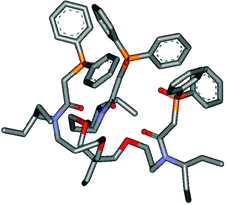Tripodal ligands build on the C-pivot (9b–e, 13b–d, and 17a–d) and trialkylbenzene platforms (10a,b, 11, 12, 14a,b, and 18a,b) bearing (N-alkylated) carbamoylmethylphosphine oxide (CMPO), carbamoylmethylphosphonate (CMP), and malonamide moieties were synthesized. Extraction studies with Am3+ and Am3+ show that in general there is a positive influence of the N-alkyl substituents in C-pivot CMP(O) ligands on the D (distribution) coefficients. The trialkylbenzene CMPO ligands 10a,b, 11, and 12 have considerably larger D coefficients than the corresponding C-pivot analogues 9a–e, although hardly having any selectivity, while N-alkylation gives rise to smaller D coefficients. Although less effective the extraction behavior of the C-pivot CMP analogues 13b–d shows more or less the same trend as the corresponding CMPO ligands 9b–e upon substitution of the carboxamide N-atom with different alkyl chains. The different malonamide ligands 17a–d and 18a,b are bad extractants, while N-alkylation makes them even worse. Potentiometric studies of CMP(O) and malonamide ligands in polymeric membranes on Pb2+, Cu2+, Ca2+, Mg2+, Na+, and K+ salts revealed that N-alkyl substituents increase the stability constants of ion–ionophore complexes compared to unsubstituted ligands. In polymeric membrane electrodes the ligands induce a selectivity pattern that differs significantly from the so-called Hofmeister series, giving the highest selectivity coefficients for UO22+ among all examined cations (Pb2+, Cu2+, Ca2+, Mg2+, Na+, K+).


 Please wait while we load your content...
Please wait while we load your content...